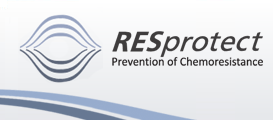| Prevention of adriamycin-induced mdrl gene amplification and expression |

|

|

|
Page 3 of 7
In particular, 105 F4-6 cells were seeded into 5 ml DMEM (Dulbeccos´s Minimum Essential Medium). Four days (86 h) later, the medium was replaced by fresh medium, and adriamycin alone, BVDU alone or BVDU + adriamycin were added to the cultures. After 72 h treatment time the medium was replaced by fresh medium and the same or higher concentrations of the substances were added. The toxic effect of adriamycin was so strong that the treatment had to be interrupted from time to time for four days where the cells were allowed to grow without treatment. In contrast to this, the growth curves for BVDU (0.5 and 1 µg/ml) were similar to those of the untreated control. Therefore, the cells of these cultures had to be serially passaged. To determine the number of living cells, a CASY 1 cell counter and analyser system (Winkelmeier et al., 1993) was used. Cell counting and volume determination is based on the displacement of conductive electrolyte by dielectric cells. The signals generated by the cells suspended in an electrolyte are evaluated by pulse area analysis. The pulse area of the signal is strictly proportional to the volume of the particle generating the signal. In dead cells the integrity of the cell membrane is lost. This loss increases the conductivity and reduces the pulse area of the electric signal. Thus, to exclude debris and dead cells, only particles with a size of 6 – 10 µm were counted as vital cells. To ensure that mdr gene amplification is involved during the treatment of F4-6 cells, we performed a differential polymerase chain reaction as described by Frye et al. (Frye et al., 1989). The method is based on a simultaneous PCR amplification of a single copy gene together with the gene of interest (here mdr1a). It has been shown that the PCR product yield (i.e. differences in signal intensities) is preserved during later cycles with differential PCR but not with conventional PCR. Interferon- g (IFNG) was used as single copy reference gene. The DNA from appr. 1 x 106 cells was purified with the „InViSorb“ genomic DNA purification kit (InViTek, Berlin, Germany). The PCR mixtures (reaction volume 50µl) contained the target DNA sample, 200 pM of each primer, 1 Unit Taq polymerase, 0.25 mM of each dNTP and a reaction buffer containing 50 mM KCl, 1.5 mM MgCl2, 10 mM Tris-HCl (pH 8.3). Aliquots of the genomic DNA were amplified as follows: Initial denaturation at 99° C for 3 minutes, initial annealing with addition of Taq polymerase at 52° C for 4 min. The following 35 cycles included 30 sec of denaturation and annealing (96° C, 52° C) and an extension at 72° C for 2.5 min except for the final extension step which had 12.5 min. PCR reactions were performed using 4 different primers: MMIFN1:5’-GTGCTGCCGTCATTTTCTGC-3’, MMIFN2: 5’-CCCTTTCTTCCCTTC TTCGTTC-3’, MMMDR1A-3: 5’-GGTGGATATGGGGGACTTTTGG TA-3’, MMDR1A-4: 5’-CCCCGTGCAGGCTTTTCTTCA-3’.
|
|||||||||


